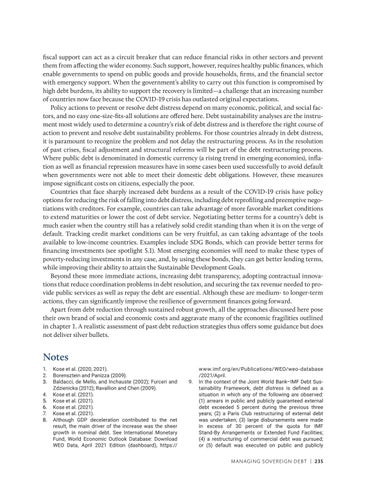fiscal support can act as a circuit breaker that can reduce financial risks in other sectors and prevent them from affecting the wider economy. Such support, however, requires healthy public finances, which enable governments to spend on public goods and provide households, firms, and the financial sector with emergency support. When the government’s ability to carry out this function is compromised by high debt burdens, its ability to support the recovery is limited—a challenge that an increasing number of countries now face because the COVID-19 crisis has outlasted original expectations. Policy actions to prevent or resolve debt distress depend on many economic, political, and social factors, and no easy one-size-fits-all solutions are offered here. Debt sustainability analyses are the instrument most widely used to determine a country’s risk of debt distress and is therefore the right course of action to prevent and resolve debt sustainability problems. For those countries already in debt distress, it is paramount to recognize the problem and not delay the restructuring process. As in the resolution of past crises, fiscal adjustment and structural reforms will be part of the debt restructuring process. Where public debt is denominated in domestic currency (a rising trend in emerging economies), inflation as well as financial repression measures have in some cases been used successfully to avoid default when governments were not able to meet their domestic debt obligations. However, these measures impose significant costs on citizens, especially the poor. Countries that face sharply increased debt burdens as a result of the COVID-19 crisis have policy options for reducing the risk of falling into debt distress, including debt reprofiling and preemptive negotiations with creditors. For example, countries can take advantage of more favorable market conditions to extend maturities or lower the cost of debt service. Negotiating better terms for a country’s debt is much easier when the country still has a relatively solid credit standing than when it is on the verge of default. Tracking credit market conditions can be very fruitful, as can taking advantage of the tools available to low-income countries. Examples include SDG Bonds, which can provide better terms for financing investments (see spotlight 5.1). Most emerging economies will need to make these types of poverty-reducing investments in any case, and, by using these bonds, they can get better lending terms, while improving their ability to attain the Sustainable Development Goals. Beyond these more immediate actions, increasing debt transparency, adopting contractual innovations that reduce coordination problems in debt resolution, and securing the tax revenue needed to provide public services as well as repay the debt are essential. Although these are medium- to longer-term actions, they can significantly improve the resilience of government finances going forward. Apart from debt reduction through sustained robust growth, all the approaches discussed here pose their own brand of social and economic costs and aggravate many of the economic fragilities outlined in chapter 1. A realistic assessment of past debt reduction strategies thus offers some guidance but does not deliver silver bullets.
Notes 1. 2. 3. 4. 5. 6. 7. 8.
Kose et al. (2020, 2021). Borensztein and Panizza (2009). Baldacci, de Mello, and Inchauste (2002); Furceri and Zdzienicka (2012); Ravallion and Chen (2009). Kose et al. (2021). Kose et al. (2021). Kose et al. (2021). Kose et al. (2021). Although GDP deceleration contributed to the net result, the main driver of the increase was the sheer growth in nominal debt. See International Monetary Fund, World Economic Outlook Database: Download WEO Data, April 2021 Edition (dashboard), https://
9.
www.imf.org/en/Publications/WEO/weo-database /2021/April. In the context of the Joint World Bank–IMF Debt Sustainability Framework, debt distress is defined as a situation in which any of the following are observed: (1) arrears in public and publicly guaranteed external debt exceeded 5 percent during the previous three years; (2) a Paris Club restructuring of external debt was undertaken; (3) large disbursements were made in excess of 30 percent of the quota for IMF Stand-By Arrangements or Extended Fund Facilities; (4) a restructuring of commercial debt was pursued; or (5) default was executed on public and publicly MANAGING SOVEREIGN DEBT | 235

